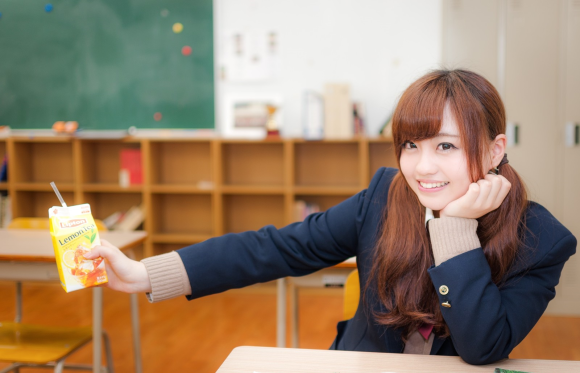
New generation shows new tastes in subtly personalizing school uniforms, according to survey.
Fashion trends change quickly in Japan, and that’s especially true for teens. Japanese high school only lasts three years, meaning that any particular look has only a short window of time before being associated with the last class of students and thus losing its luster.
Even though Japanese high schoolers wear a uniform five days of the week, they still find ways of personalizing their ensembles. So how has Japanese schoolgirl fashion changed over the last few years?
1. Knee-length skirts
https://twitter.com/gxaenm/status/716602877750304768Contrary to what anime depicts, most schools have dress codes that prohibit scandalously short skirts. However, during the late 1990s and early 2000s it became increasingly common for schoolgirls to roll their skirts up at the waist when on their way to or from campus, or socializing with friends out in town after class.
A recent poll of 154 high school girls, though, showed a change in attitudes. 37.7 percent said they wore a knee-length skirt, compared to only 21.4 percent who said their skirts were more than five centimeters (2 inches) above the knee.
2. Short socks
今日の制服コーデです。先日のコーデにELLEECOLEのベストとEASTBOYのリボンを合わせました。バッグはイザックの黒リュック。 pic.twitter.com/4CnGMkBULl
— 高橋こうき (@ktakahashi0203) August 14, 2016
Another trend of the late ‘90s was the “loose socks” look, in which schoolgirls would wear baggy socks that almost looked like leg warmers. Some loose socks were so loose that wearers had to apply adhesive, called “sock touch,” to their calves to keep them from falling all the way down to their ankles. The logic behind the trend was that having thick, bunched up socks made the wearer’s legs look thinner by comparison.
That’s not such a problem today, as in the same poll mentioned above only 0.6 percent of respondents said they wear loose socks. And while knee-high socks, or socks that come up to the bottom of the knee, had become quite common over the last few years, they weren’t the most popular choice either, accounting for just 15.6 percent.
Instead, the most popular sock choice was a snugly fitting short sock that comes only part-way up the calf, chosen by 44.2 percent of respondents. The rationale is similar to the previous one for loose socks: wearing shorter socks makes the wearer’s legs appear longer.
Youth trends being what they are, though, it’s probably only a matter of time until what’s popular changes all over again.
Sources: Naver Matome, Woman Insight, Wotopi
Top image: Pakutaso

 Japan’s schoolgirl roomwear outfits are ready for winter with new, extra-warm versions
Japan’s schoolgirl roomwear outfits are ready for winter with new, extra-warm versions The surprisingly deep differences of sailor suit school uniform collar styes – Kanto-eri and more
The surprisingly deep differences of sailor suit school uniform collar styes – Kanto-eri and more Japanese Twitter user illustrates the difference between schoolgirl uniforms in major cities
Japanese Twitter user illustrates the difference between schoolgirl uniforms in major cities RocketNews24’s Meg models the entire line of Japan’s new schoolgirl outfit loungewear 【Photos】
RocketNews24’s Meg models the entire line of Japan’s new schoolgirl outfit loungewear 【Photos】 Japanese schoolgirls’ hemlines are still up, but socklines are way down
Japanese schoolgirls’ hemlines are still up, but socklines are way down We revisited Sweets Paradise after a decade to see if Japan’s dessert buffet still delivers
We revisited Sweets Paradise after a decade to see if Japan’s dessert buffet still delivers Hayao Miyazaki says Happy New Year to Studio Ghibli fans with new art for Year of the Horse
Hayao Miyazaki says Happy New Year to Studio Ghibli fans with new art for Year of the Horse We test Daiso’s new storage container to see if it keeps rice fluffy even after freezing
We test Daiso’s new storage container to see if it keeps rice fluffy even after freezing Japanese-style accommodation at the new Premium Dormy Inn hotel in Asakusa will blow your mind
Japanese-style accommodation at the new Premium Dormy Inn hotel in Asakusa will blow your mind Japanese thug wear from Birth Japan perfect for those breaking bad next year
Japanese thug wear from Birth Japan perfect for those breaking bad next year Cosplay costume room tour by Japan’s number-one cosplayer Enako is an eye-opener【Video】
Cosplay costume room tour by Japan’s number-one cosplayer Enako is an eye-opener【Video】 Uniqlo Ukiyo-e Blue T-shirts: A cool-hued reinterpretation of some of Japan’s greatest paintings
Uniqlo Ukiyo-e Blue T-shirts: A cool-hued reinterpretation of some of Japan’s greatest paintings Stamina-destroying “Paralysis Noodles” are Tokyo’s newest over-the-top ramen innovation
Stamina-destroying “Paralysis Noodles” are Tokyo’s newest over-the-top ramen innovation Starbucks teams up with 166-year-old Kyoto doll maker for Year of the Horse decorations【Photos】
Starbucks teams up with 166-year-old Kyoto doll maker for Year of the Horse decorations【Photos】 Uniqlo opens its first-ever cafe at newly revamped Ginza store
Uniqlo opens its first-ever cafe at newly revamped Ginza store Starbucks Japan ready to get Year of the Horse started with adorable drinkware and plushies【Pics】
Starbucks Japan ready to get Year of the Horse started with adorable drinkware and plushies【Pics】 Cyberpunk anime meets traditional culture in Ghost in the Shell gold leaf Japanese changing screens
Cyberpunk anime meets traditional culture in Ghost in the Shell gold leaf Japanese changing screens 7 great places to see Mt. Fuji from without having to climb it
7 great places to see Mt. Fuji from without having to climb it Hello Kitty Choco Egg figures are an adorable trip through three periods of Japanese pop culture【Pics】
Hello Kitty Choco Egg figures are an adorable trip through three periods of Japanese pop culture【Pics】 7-Eleven Japan’s ramen-cooking robot whipped us up a bowl of noodles【Taste test】
7-Eleven Japan’s ramen-cooking robot whipped us up a bowl of noodles【Taste test】 We found possibly the quietest Japanese-style hotel in Tokyo’s bustling Shinjuku district
We found possibly the quietest Japanese-style hotel in Tokyo’s bustling Shinjuku district Japan’s otoshidama tradition of giving kids money at New Year’s gets a social welfare upgrade
Japan’s otoshidama tradition of giving kids money at New Year’s gets a social welfare upgrade Sumo Sanrio! Hello Kitty and pals team up with Japan Sumo Association for new merch【Pics】
Sumo Sanrio! Hello Kitty and pals team up with Japan Sumo Association for new merch【Pics】 More Than a Capsule Stay: Why Solo Travelers Choose “global cabin Yokohama Chinatown”
More Than a Capsule Stay: Why Solo Travelers Choose “global cabin Yokohama Chinatown” Japan’s oldest largetooth sawfish in captivity back on display in Mie Prefecture
Japan’s oldest largetooth sawfish in captivity back on display in Mie Prefecture 7-Eleven Japan starts new temporary luggage storage service in over 300 branches
7-Eleven Japan starts new temporary luggage storage service in over 300 branches Disillusionment at Tsukiji’s tourist-target prices led us to a great ramen restaurant in Tokyo
Disillusionment at Tsukiji’s tourist-target prices led us to a great ramen restaurant in Tokyo Tokyo considering law requiring more trash cans following litter increase in heavily touristed area
Tokyo considering law requiring more trash cans following litter increase in heavily touristed area Tokyo’s Tsukiji sushi neighborhood asks tour groups to stay away for the rest of the month
Tokyo’s Tsukiji sushi neighborhood asks tour groups to stay away for the rest of the month Tokyo event lets you travel back in time, for free, to celebrate 100 years since Showa era start
Tokyo event lets you travel back in time, for free, to celebrate 100 years since Showa era start Sanrio theme park in Japan announces plans to expand into a Sanrio resort
Sanrio theme park in Japan announces plans to expand into a Sanrio resort Japan may add Japanese language proficiency, lifestyle classes to permanent foreign resident requirements
Japan may add Japanese language proficiency, lifestyle classes to permanent foreign resident requirements Survey asks foreign tourists what bothered them in Japan, more than half gave same answer
Survey asks foreign tourists what bothered them in Japan, more than half gave same answer Japan’s human washing machines will go on sale to general public, demos to be held in Tokyo
Japan’s human washing machines will go on sale to general public, demos to be held in Tokyo Japan’s deadliest food claims more victims, but why do people keep eating it for New Year’s?
Japan’s deadliest food claims more victims, but why do people keep eating it for New Year’s? We deeply regret going into this tunnel on our walk in the mountains of Japan
We deeply regret going into this tunnel on our walk in the mountains of Japan Studio Ghibli releases Kodama forest spirits from Princess Mononoke to light up your home
Studio Ghibli releases Kodama forest spirits from Princess Mononoke to light up your home Major Japanese hotel chain says reservations via overseas booking sites may not be valid
Major Japanese hotel chain says reservations via overseas booking sites may not be valid Put sesame oil in your coffee? Japanese maker says it’s the best way to start your day【Taste test】
Put sesame oil in your coffee? Japanese maker says it’s the best way to start your day【Taste test】 No more using real katana for tourism activities, Japan’s National Police Agency says
No more using real katana for tourism activities, Japan’s National Police Agency says Starbucks Japan reveals new sakura drinkware collection, inspired by evening cherry blossoms
Starbucks Japan reveals new sakura drinkware collection, inspired by evening cherry blossoms Updated cherry blossom forecast shows extra-long sakura season for Japan this year
Updated cherry blossom forecast shows extra-long sakura season for Japan this year Japanese schoolgirl roomwear takes sailor suit uniform to another level as wearable blanket
Japanese schoolgirl roomwear takes sailor suit uniform to another level as wearable blanket Thai schoolgirl uniforms poised to edge out traditional Japanese ones in Japan?
Thai schoolgirl uniforms poised to edge out traditional Japanese ones in Japan? How to fold an entire origami schoolgirl, sailor suit and all, out of a single piece of paper
How to fold an entire origami schoolgirl, sailor suit and all, out of a single piece of paper Japanese School Swimsuits for Adults line releases new design with body-slimming styling
Japanese School Swimsuits for Adults line releases new design with body-slimming styling School bag cushions: The ultimate Japanese schoolgirl accessory
School bag cushions: The ultimate Japanese schoolgirl accessory “Short skirts cause sexual assaults” according to Japanese school uniform poster
“Short skirts cause sexual assaults” according to Japanese school uniform poster Japanese schoolgirls in sailor suit uniforms demonstrate 82 sumo techniques【Video】
Japanese schoolgirls in sailor suit uniforms demonstrate 82 sumo techniques【Video】 Snappy as they look, Japanese school uniforms can be an extremely expensive hassle for parents
Snappy as they look, Japanese school uniforms can be an extremely expensive hassle for parents Not everyone hates school uniforms: Japanese Twitter shows us why
Not everyone hates school uniforms: Japanese Twitter shows us why Manga artist wants Japanese teachers to feel, for two seconds, how dumb their girls’ dress code is
Manga artist wants Japanese teachers to feel, for two seconds, how dumb their girls’ dress code is Japan’s iconic P.E. uniform becomes one-piece dress in latest schoolgirl-themed fashion offering
Japan’s iconic P.E. uniform becomes one-piece dress in latest schoolgirl-themed fashion offering Cosplay like an angelic student in a winged Japanese schoolgirl uniform
Cosplay like an angelic student in a winged Japanese schoolgirl uniform Japanese public school to allow male students to wear skirts, chest ribbons as part of uniform
Japanese public school to allow male students to wear skirts, chest ribbons as part of uniform
Leave a Reply